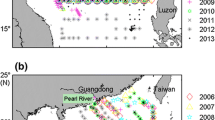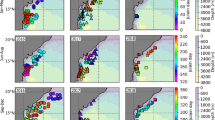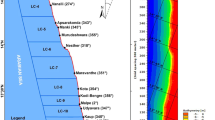Abstract
The current lack of high-precision information on subsurface seawater is a constraint in fishery research. Based on Argo temperature and salinity profiles, this study applied the gradient-dependent optimal interpolation to reconstruct daily subsurface oceanic environmental information according to fishery dates and locations. The relationship between subsurface information and matching yellowfin tuna (YFT) in the western and central Pacific Ocean (WCPO) was examined using catch data from January 1, 2008 to August 31, 2017. The seawater temperature and salinity results showed differences of less than ±0.5°C and ±0.01 compared with the truth observations respectively. Statistical analysis revealed that the most suitable temperature for YFT fishery was 28–29°C at the near-surface. The most suitable salinity range for YFT fishery was 34.5–36.0 at depths shallower than 300 m. The suitable upper and lower bounds on the depths of the thermocline were 90–100 m and 300–350 m, respectively. The thermocline characteristics were prominent, with a mean temperature gradient exceeding 0.08°C/m. These results indicate that the profiles constructed by gradient-dependent optimal interpolation were more accurate than those of the nearest profiles adopted.
Similar content being viewed by others
References
Bonanno R, Lacavalla M, Sperati S. 2019. A new high-resolution Meteorological Reanalysis Italian Dataset: MERIDA. Quarterly Journal of the Royal Meteorological Society, 145(721): 1756–1779, doi: https://doi.org/10.1002/qj.3530
Burgess T M, Webster R. 1980. Optimal interpolation and isarithmic mapping of soil properties: I. The semi-variogram and punctual kriging. European Journal of Soil Science, 31(2): 315–331, doi: https://doi.org/10.1111/j.1365-2389.1980.tb02084.x
Chu P C, Fan Chenwu. 2011. Maximum angle method for determining mixed layer depth from seaglider data. Journal of Oceanography, 67(2): 219–230, doi: https://doi.org/10.1007/s10872-011-0019-2
De Feis I, Masiello G, Cersosimo A. 2020. Optimal interpolation for infrared products from hyperspectral satellite imagers and sounders. Sensors, 20(8): 2352, doi: https://doi.org/10.3390/s20082352
Fiúza A F G. 1990. Applications of satellite remote sensing to fisheries. In: Operations Research and Management in Fishing. Dordrecht, The Netherlands: Springer, 257–279
Gandin L S. 1963. Objective Analysis of Meteorological Fields. Leningrad, USSR: Gidrometeoizdat, 158–210
Johnson K S, Plant J N, Riser S C, et al. 2015. Air oxygen calibration of oxygen optodes on a profiling float array. Journal of Atmospheric and Oceanic Technology, 32(11): 2160–2172, doi: https://doi.org/10.1175/JTECH-D-15-0101.1
Kalnay E. 2003. Atmospheric Modeling, Data Assimilation and Predictability. Cambridge, UK: Cambridge University Press, 129
Klemas V, Yan Xiaohai. 2014. Subsurface and deeper ocean remote sensing from satellites: An overview and new results. Progress in Oceanography, 122: 1–9, doi: https://doi.org/10.1016/j.pocean.2013.11.010
Kluger L C, Taylor M H, Mendo J, et al. 2016. Carrying capacity simulations as a tool for ecosystem-based management of a scallop aquaculture system. Ecological Modelling, 331: 44–55, doi: https://doi.org/10.1016/j.ecolmodel.2015.09.002
Lan K W, Lee M A, Lu H J, et al. 2011. Ocean variations associated with fishing conditions for yellowfin tuna (Thunnus albacares) in the equatorial Atlantic Ocean. ICES Journal of Marine Science, 68(6): 1063–1071, doi: https://doi.org/10.1093/icesjms/fsr045
Lan K W, Shimada T, Lee M A, et al. 2017. Using remote-sensing environmental and fishery data to map potential yellowfin tuna habitats in the tropical Pacific Ocean. Remote Sensing, 9(5): 444, doi: https://doi.org/10.3390/rs9050444
Langley A, Briand K, Kirby D S, et al. 2009. Influence of oceanographic variability on recruitment of yellowfin tuna (Thunnus albacares) in the western and central Pacific Ocean. Canadian Journal of Fisheries and Aquatic Sciences, 66(9): 1462–1477, doi: https://doi.org/10.1139/F09-096
Laurs R, Fiedler P. 1985. Application of satellite remote sensing to U.S. fisheries. In: OCEANS’ 85-Ocean Engineering and the Environment. San Diego, CA, USA: IEEE, 320–323
Leroy B, Itano D, Nicol S. 2007. Preliminary analysis and observations on the vertical behaviour of WCPO skipjack, yellowfin and bigeye Tuna in association with anchored FADs, as indicated by acoustic and archival tagging data. Honolulu, HI, USA: Western and Central Pacific Fisheries Commission Scientific Committee
Liu Chao, Liang Xinfeng, Chambers D P, et al. 2020. Global patterns of spatial and temporal variability in salinity from multiple gridded Argo products. Journal of Climate, 33(20): 8751–8766, doi: https://doi.org/10.1175/JCLI-D-20-0053.1
Liu Z, Xu J, Xiu Yi, et al. 2006. The effect of reference dataset on calibration of Argo profiling float salinity data. Marine Forecasts, 23(4): 1–12
Roemmich D, Gilson J. 2009. The 2004–2008 mean and annual cycle of temperature, salinity, and steric height in the global ocean from the Argo Program. Progress in Oceanography, 82(2): 81–100, doi: https://doi.org/10.1016/j.pocean.2009.03.004
Schaefer K M, Fuller D W, Aldana G. 2014. Movements, behavior, and habitat utilization of yellowfin tuna (Thunnus albacares) in waters surrounding the Revillagigedo Islands Archipelago Biosphere Reserve, Mexico. Fisheries Oceanography, 23(1): 65–82, doi: https://doi.org/10.1111/fog.12047
Schaefer K M, Fuller D W, Block B A. 2007. Movements, behavior, and habitat utilization of yellowfin tuna (Thunnus albacares) in the northeastern Pacific Ocean, ascertained through archival tag data. Marine Biology, 152(3): 503–525, doi: https://doi.org/10.1007/s00227-007-0689-x
Schaefer K M, Fuller D W, Block B A. 2009. Vertical movements and habitat utilization of skipjack (Katsuwonus pelamis), yellowfin (Thunnus albacares), and bigeye (Thunnus obesus) tunas in the equatorial eastern Pacific Ocean, ascertained through archival tag data. In: Tagging and Tracking of Marine Animals with Electronic Devices. Reviews: Methods and Technologies in Fish Biology and Fisheries. Dordrecht, The Netherlands: Springer, 9: 121–144
Schaefer K M, Fuller D W, Block B A. 2011. Movements, behavior, and habitat utilization of yellowfin tuna (Thunnus albacares) in the Pacific Ocean off Baja California, Mexico, determined from archival tag data analyses, including unscented Kalman filtering. Fisheries Research, 112(1–2): 22–37, doi: https://doi.org/10.1016/j.fishres.2011.08.006
Song L M, Wu Y P. 2011. Standardizing CPUE of yellowfin tuna (Thunnus albacares) longline fishery in the tropical waters of the northwestern Indian Ocean using a deterministic habitat-based model. Journal of Oceanography, 67(5): 541–550, doi: https://doi.org/10.1007/s10872-011-0055-y
Tong Mingrong, Liu Zenghong, Sun Chaohui, et al. 2003. Analysis of data quality control process of the ARGO profiling buoy. Ocean Technology (in Chinese), 22(4): 79–85
Wang Shaoqin, Xu Liuxiong, Zhu Guoping, et al. 2014. Spatial-temporal profiles of CPUE and relations to environmental factors for yellowfin tuna Thunnus albacores from purse-seine fishery in Western and Central Pacific Ocean. Journal of Dalian Ocean University, 29(3): 303–308
Weng K C, Stokesbury M J W, Boustany A M, et al. 2009. Habitat and behaviour of yellowfin tuna Thunnus albacares in the Gulf of Mexico determined using pop-up satellite archival tags. Journal of Fish Biology, 74(7): 1434–1449, doi: https://doi.org/10.1111/j.1095-8649.2009.02209.x
Wikle C K, Berliner L M. 2007. A Bayesian tutorial for data assimilation. Physica D: Nonlinear Phenomena, 230(1–2): 1–16, doi: https://doi.org/10.1016/j.physd.2006.09.017
Yang Shenglong, Zhang Bianbian, Jin Shaofei, et al. 2015. Relationship between the temporal-spatial distribution of longline fishing grounds of yellowfin tuna (Thunnus albacares) and the thermocline characteristics in the Western and Central Pacific Ocean. Haiyang Xuebao (in Chinese), 37(6): 78–87
Zagaglia C R, Lorenzzetti J A, Stech J L. 2004. Remote sensing data and longline catches of yellowfin tuna (Thunnus albacares) in the equatorial Atlantic. Remote Sensing of Environment, 93(1–2): 267–281, doi: https://doi.org/10.1016/j.rse.2004.07.015
Zhang Chunling, Xu Jianping, Bao Xianwen, et al. 2013. An effective method for improving the accuracy of Argo objective analysis. Acta Oceanologica Sinica, 32(7): 66–77, doi: https://doi.org/10.1007/s13131-013-0333-1
Zhang Chunling, Xu Jianping, Bao Xianwen. 2015. Gradient-dependent correlation scale method based on Argo. Journal of PLA University of Science and Technology (Natural Science Edition) (in Chinese), 16(5): 476–483
Acknowledgements
The research is supported by the China National Scientific Seafloor Observatory. We are grateful to the SKFC of China for providing us with the data from the WCPO purse seine fishery, the China Argo Real-time Data Center for the near-real-time observations, and the National Oceanographic Data Center for providing us with the climate data. We thank Wiley Editing Services (www.wileyauthors.com/eeo/preparation) for editing this manuscript.
Funding
The National Natural Science Foundation of China under contract No. 4210060098; the Foundation of Key Laboratory of Sustainable Exploitation of Oceanic Fisheries Resources under contract No. A1-2006-21-200201.
Author information
Authors and Affiliations
Corresponding authors
Rights and permissions
About this article
Cite this article
Zhang, C., Wang, D. & Wang, Z. Fishery analysis using gradient-dependent optimal interpolation. Acta Oceanol. Sin. 41, 116–126 (2022). https://doi.org/10.1007/s13131-021-1895-y
Received:
Accepted:
Published:
Issue Date:
DOI: https://doi.org/10.1007/s13131-021-1895-y




